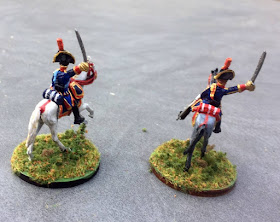The Spanish Heavy Cavalry ("Line Cavalry"), like their infantry brethren, saw their uniforms undergo numerous changes in the earlier part of the Napoleonic Wars. in the late 1780's to 1790's, the regimnents wore coats in varied colors by regiment (dark blue, white, or scarlet) with regimental facing colors. In 1796, all regimnents changed to white coats with scarlet turnbacks and regimental facing colors. In 1800, the Cavalry of the Line wore dark blue coats with scarlet turnback and piping, buff breeches and waistcoats, pewter buttons, white lace on the beicornes, and scarlet saddle blankets edged in white. The regimental facing colors were as per the table below.
Spanish Line Cavalry, 1800 facing colors
Regiment
|
Collar
|
Cuffs
|
Lapels
|
Rey
|
Scarlet
|
Scarlet
|
Violet
|
Reina
|
Violet
|
Scarlet
|
Scarlet
|
Principe
|
Scarlet
|
Scarlet
|
|
Infante
|
White
|
Violet
|
White
|
Borbon
|
White
|
White
|
Scarlet
|
Farnesio
|
Scarlet
|
Scarlet
|
White
|
Alcantara
|
Green
|
Green
|
Green
|
Espana
|
Black
|
Black
|
Black
|
Algarve
|
Sky Blue
|
Sky Blue
|
Buff
|
Calatrava
|
Scarlet
|
White
|
Scarlet
|
Santiago
|
Crimson
|
Crimson
|
Crimson
|
Montessa
|
White
|
Buff
|
White
|
Carabineros
|
Sky Blue
|
Sky Blue
|
Sky Blue
|
In 1802, the uniform changed yet again, now with all units dressed the same, namely dark blue coats with white lapels, crimson collars, cuffs, and turnbacks, all of which were piped in white. The lapels were piped in crimson. The buttons were brass and the waistcoats yellow. The bicorns had a yellow lace edging. The pants were blue with a crimson stripe.
Still another change occurred in the uniforms of the Heavy Cavalry in 1805, with a return to regimental facings on the dark blue coats, and a return to buff breeches and waistcoats. The saddle blankets remained dark blue, with the piping on the shabraques and the lace edging on the bicorns being in the regimental button color (yellow or white).
Spanish Line Cavalry, 1805 facing colors
Regiment
|
Collar
|
Cuffs
|
Lapels
|
Piping
|
Turnbacks
|
Buttons
|
Rey
|
Scarlet
|
Scarlet
|
Scarlet
|
Scarlet
|
Scarlet
|
Brass
|
Reina
|
Sky Blue
|
Sky Blue
|
Sky Blue
|
Scarlet
|
Scarlet
|
Pewter
|
Principe
|
Scarlet
|
Scarlet
|
Scarlet
|
Scarlet
|
Scarlet
|
Brass
|
Infante
|
White
|
White
|
White
|
White
|
Scarlet
|
Brass
|
Borbon
|
Scarlet
|
Scarlet
|
Scarlet
|
Scarlet
|
Scarlet
|
Pewter
|
Farnesio
|
Scarlet
|
Scarlet
|
Scarlet
|
Buff
|
Scarlet
|
Pewter
|
Alcantara
|
Buff
|
Scarlet
|
Buff
|
Scarlet
|
Green
|
Pewter
|
Espana
|
Buff
|
Crimson*
|
Crimson*
|
Scarlet
|
Scarlet
|
Pewter
|
Algarve
|
Buff
|
Buff
|
Buff
|
Scarlet
|
Scarlet
|
Pewter
|
Calatrava
|
Scarlet
|
Sky Blue
|
Sky Blue
|
Scarlet
|
Scarlet
|
Pewter
|
Santiago
|
Crimson
|
Crimson
|
Crimson
|
Scarlet
|
Scarlet
|
Pewter
|
Montessa
|
Crimson*
|
Crimson*
|
White
|
Scarlet
|
Scarlet
|
Pewter
|
* = piping in the text color (buff or white).
This is the Algarve regiment of Line Cavalry; once again the trumpeter and standard bearer will be added soon.
Being a regiment with Pewter buttons, the lace on the bicorn and the trim on the shabraques is white, as opposed to the yellow seen previously with the Regimiento del Rey.
These are once again Brigade Games figures, sculpts b y Paul Hicks.
This shot shows the buff color of the collars better. Curiously, the Algarve is the Southernmost region of Portugal, now days famous for its beaches. It was occupied by Spain from 1807 - 1808 as part of the joint invasion of Portugal with the French.
They look quite dapper astride their chestnut horses, eh?!









































